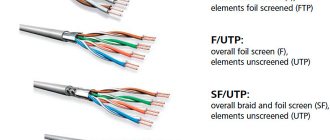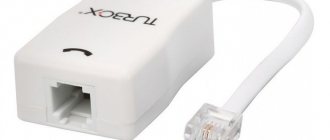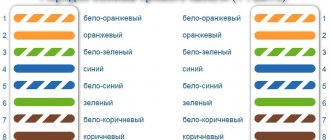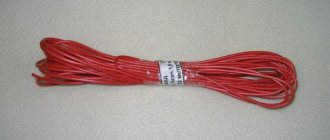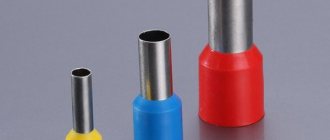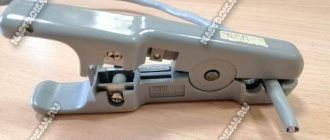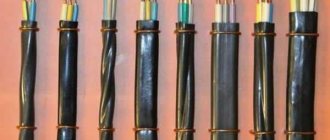About wired and wireless technologies
Modern manufacturers of computer equipment and peripherals, as well as mobile phones, are gradually replacing cable transmission of data and electricity with wireless.
Prominent examples of this trend include wireless headphones and chargers. Wireless data transfer protocols wi-fi and bluetooth have become widespread.
It is quite possible that a point in time will soon come when computers and other electronic devices located at great distances from each other will communicate with each other using wireless data transfer protocols.
However, now, for the local computer network and peripheral devices to computers, ordinary cables are used. Below we will tell you about their types and features.
To connect computers on a local network or to connect them to a global network, a network cable is used.
Audio connector mini-jack (3.5 mm)
Also known as : headphone jack.
Description : The most common audio connector in the world. On most computers, tablets and phones it is designed as a 3.5 mm jack and connects most wired headphones, speakers to a computer or gadget. Moreover, computers, as a rule, have two or more audio jacks for a microphone and headphones, speakers for 3.1, 5.1 or even 7.1 sound format. And mobile gadgets have only one headset port.
Adapter Needed : If your device does not have a 3.5mm jack, you may want to consider purchasing a wired USB headset or Bluetooth wireless audio device or a USB-to-3.5mm . Fortunately, the cost of each option exceeds $10.
Options for 3.5 mini jack adapters
Basic types of cables for network connections between computers
The following types of network cables are widely used:
- Coaxial;
- With twisted pair;
- Fiber optic.
Coaxial network cable
The oldest type of network cable among all types of network cables is coaxial cable. Nowadays it is used quite rarely, but there are situations when it is simply necessary.
Structurally, this type of cable is a metal conductor with insulation and braiding made of copper or aluminum. Special sockets of the BNC and BNC-T types are used as connecting points of the network cable.
The main disadvantage of this cable is its low resistance to the influence of the electromagnetic field. Those times when computers were connected to each other using a coaxial cable are long gone into history.
However, now such a cable is used when connecting satellite dishes. In addition, coaxial cable has excellent speed characteristics when transmitting analog and digital signals simultaneously. In this regard, it is often used in cable television.
Twisted pair cable
The next in the evolution of network cables for connecting computers was a cable consisting of a twisted pair. Why did they call this type of cable so? The fact is that this cable consists of copper conductors with insulation, which are intertwined in pairs.
The standard cable is one that has four pairs of cores, that is, a total of eight wires. However, on the market you can find a cable with two twisted pairs, which contains four copper conductors.
Color marking of insulation is carried out in accordance with the regulations. Manufacturers may use copper braiding or aluminum foil to protect the twisted pair cable.
Depending on the protection used, twisted pair cables can be of the following types:
- UTP. This marking indicates that the twisted pair cable does not have additional protection. The conductors in this cable have conventional plastic protection;
- F/UTP- is a twisted pair conductor and all of them are braided with foil;
- STP – each pair of conductors is braided with protective foil;
- S/FTP - here, in addition to the foil braid for each pair, an additional copper shield is used to protect the conductors;
- SF/UTP - each conductor is protected by a foil braid and a copper shield.
A twisted pair cable that does not have protection is cheaper than protected cables. The use of a twisted pair cable with all degrees of protection makes sense for high-quality data transmission over long distances.
In addition to the above markings, twisted pair cables are marked from CAT1 to CAT7. The higher the numerical value of this marking, the more preferable the choice of cable. To create a computer local network, a cable marked CAT5 is quite suitable. However, experts recommend using CAT5e cable, since compared to CAT5 it has better throughput of high-frequency signals.
Using a twisted pair cable, computers and other electronic devices are connected at a distance of no more than 100 meters from each device.
Fiber optic network cable
Fiber optic cable is the most modern type of cable used to build computer networks. The main advantages of this cable are the unlimited speed of information transfer and a high degree of protection from external factors.
Using this cable, you can build a network that will transmit data over a distance of up to 100 km. The price of fiber optic cable is low. However, the connectors and other equipment used for it are quite expensive. In addition, when working with such equipment you need to have special knowledge and skills.
Those people who are just beginning to study the theoretical part of building computer networks and apply this knowledge in practice need to pay attention to the fact that peripheral devices are connected to the computer via completely different cables.
A USB cable is used to connect mobile phones, printers, scanners and other electronic devices. Using such a cable, you can charge some models of mobile phones and digital audio video players that have lost their charger.
HDMI/VGA/DVI cables are used to connect a computer video card to a monitor or TV.
DisplayPort/Mini DisplayPort
Also known as : dual purpose port.
Description : DisplayPort today is the most advanced standard for connecting monitors to a computer, with the ability to display images with a resolution of 4K and 60 Hz on one monitor, or up to three monitors in Full HD format (using a hub or docking station). Most laptops that have DisplayPort use a mini DisplayPort or DisplayPort Type-C connector over a USB port.
Still, most monitors and TVs don't have a DisplayPort connector, but you can output to an HDMI-compatible display with an adapter that costs less than $10. Like HDMI, DisplayPort can output audio in the same cable as video.
Adapter needed : If you want to display an image on more than one monitor from one mini DisplayPort port on a laptop, then you need a multi-threaded DisplayPort hub , which costs from $70 to $100 and requires electricity. A single USB (Type-C)-to-DisplayPort cable or mini DisplayPort-to-DisplayPort cable costs just over $10.
mini-DisplayPort, DisplayPort
USB 3.1 Gen 1
Also known as : USB 3.1, SuperSpeed USB.
Description : USB 3.1 Gen 1 is a communication protocol that operates at the same 5 Gbps speed as USB 3.0, but it only works with USB Type-C. This provides backward compatibility with USB 3.0 and USB 2.0 devices, provided that the cable has a Type-C connector on at least one side. USB 3.1 devices can support USB device charging, which allows them to receive or transmit power at speeds of up to 100W, which is enough to charge most laptops.
USB 3.1 Gen 1
USB 3.1 Gen 2
Also known as : USB 3.1, SuperSpeed+USB, SuperSpeed USB 10Gbps.
Description: USB 3.1 Gen 2 has the same form factor as USB 3.1 Gen 1, but with double the bandwidth, allowing it to transfer data at speeds of up to 10 Gbps. To ensure backward compatibility with USB 3.1 Gen 2 USB adapters, a Type C connector will be required, but to use it at full speed, you'll need to make sure the cable is rated for 10 Gbps. This is usually marked with the "ss" logo or in blue.
USB 3.1 Gen 2
Shell material
| PVC (Internal) | PVC is the cheapest material |
| PP (External) | Polypropylene, for external use at high degrees - over 100 Celsius |
| Pe (External) | Polyethylene. |
| B | Armored with steel outer tube |
| FR | Fire resistant in fire hazardous areas. |
| C | There is a plastic and steel core inside. Plus, on the outside there is a cable for stretching the wire between buildings. |
| L.S. | Does not emit dangerous smoke when burning |
| ZH | When burning does not emit halogen gases |
DVI port
Also known as : DVI-D, DVI-I, Dual-Link DVI.
Description : Due to the physical dimensions of DVI, not every laptop is equipped with this interface. But almost every monitor with Full HD resolution has a DVI port. Often DVI will be the best option for connecting your computer and monitor, as many budget displays only have DVI and VGA connectors. Fortunately, if the need arises, you can purchase an adapter to convert from HDMI or DisplayPort to DVI.
DVI can output images up to a resolution of 1920 x 1200 at 60 Hz. For 2K or 4K monitors at 30 Hz, a second connection is required - the so-called Dual-Link DVI. By virtue of its name, it can provide image output with a resolution of 1920 x 1200 at 120 Hz.
Most basic USB docking stations have at least one DVI output.
Adapter Needs : You can find an HDMI to DVI for under $10 and a DisplayPort to DVI cable for under $15. The cheapest cable is DVI-VGA for about $5. USB docking stations with output for two DVI monitors start at $90.
HDMI-DVI adapter, DVI cable
Mini USB
Also known as : Mini-B, mini USB.
Description : The interface is already less popular than micro USB, as it is older. Used on some external hard drives, game consoles and other accessories. They, like micro USB, are not used on laptops and computers. They can be found on mobile phones or some players. But even with the advent of micro USB, the use of this port is very rare these days.
Adapter requirements : A Type-A to mini USB costs around $5, a Type-C to mini USB is available for under $10, and a micro USB to USB costs about $5.
Type-A cable - mini USB, micro USB - USB adapter
MicroSD adapter
Also known as : MicroSD memory card slot, MicroSDHC reader, microSDXC.
Description : This slot reads MicroSD memory cards, which are used by the vast majority of modern smartphones, tablets, players and other mobile gadgets. If your laptop or tablet has a very limited amount of internal disk memory, then a MicroSD adapter will save you. It will allow you to expand the internal memory using a large MicroSD memory card of 64 GB or 128 GB.
Need for an adapter : If your device does not have a built-in slot for a MicroSD card, then I advise you to purchase an external MicroSD adapter , which will cost you about $10.
MicroSD adapter
Micro USB
Also known as : Micro-B, MicroUSB.
Description : This small port has gained a reputation as a port for charging smartphones and low-power tablets. This connector is not used on laptops and PCs. Regular micro USB supports USB 2.0 speed (480 Mbps) and allows you to connect multiple devices, mainly external hard drives. Micro USB 3.0 ports have some extra pins and offer faster transfer speeds, but the form factor is exactly the same as micro USB 3.0.
Adapter required : In order to connect a phone or tablet to a laptop, you will need a USB Type-A - micro USB cable, which costs about $5. You can also use a Type-C to micro USB for $10.
Micro USB 2.0, Micro USB 3.0
USB Type-C
Also known as : USB-C.
Description : This slim USB port is the newest USB standard. The port is already available on a number of devices, and will likely replace USB Type-A, USB Type-B and MicroUSB on all new systems in the near future. It is much thinner than its predecessors. Type-C can fit on very thin laptops, such as the MacBook 12″. The USB Type-C connector is symmetrical, so you never have to worry about the position of the plug when plugging it into a port that allows you to insert the cable either way. Apple has clearly demonstrated this with its Lightning connector, introducing USB Type-C into all of its devices.
USB Type-C ports can support several different standards, but not all of them offer the same functionality. Type-C can transfer files to either USB 3.1 Gen 1 (at 5 Gbps) or USB 3.1 Gen 2 (at 10 Gbps). It can be used as a charging port (USB-PD), so you can charge your laptop with it. It can also carry DisplayPort signals, and even act as a Thunderbolt port.
Manufacturers may indicate USB 3.1 Gen 2 compatibility with a battery logo (available for charging devices), and a lightning bolt logo next to the port indicates a Thunderbolt 3 port. To learn more about Thunderbolt 3, see Thunderbolt 3 - The World's Fastest Interface.
Need for an adapter : If you have a rectangular USB Type-A port, but need to connect a device with USB Type-C, use a USB-C 3.0 (Type C) to USB-A 3.0 .
USB Type-C to USB Type-A cable
What is the difference
In particular, a copper pair differs only in the braid class. There are so-called street cables; they have a thicker braid and a shielded layer, which additionally protects the wire from electromagnetic influence. It’s not for nothing that twisted pair has this appearance and name. Each pair carries the same signal, which is added at the output. As a result, errors in data transmission can be avoided.
And these errors appear precisely due to the influence of the external environment. For internal installation, UTP cables are most often used. Let's first look at the name. The last two letters TP are the abbreviation for Twisted Pair or twisted pair. But the first letter indicates the class. Further in each chapter we will gradually reveal the secrets of twisted pair cable marking.
USB 2.0 interface
Also known as : Hi-Speed USB, USB 2.
Description : Capable of transferring data at speeds up to 480 Mbps, USB 2.0 is the most common USB and works effectively with most peripheral devices. The USB 2.0 port can be made in various form factors: Type A - Type A (rectangular), Type B - Type-B (square), mini - mini USB or micro - micro USB. On laptops and desktops the USB 2.0 port will always be Type A, while on tablets and phones it will most likely be micro USB.
USB 2.0 ports
VGA connector
Description : Now we can already say: VGA is the great-grandfather of video outputs. VGA (video graphics array) appeared back in 1987, but this connector is still a common feature on many monitors and projectors even today. However, since the 15-pin connector is quite large, you won't find many current generation laptops or desktops that have a VGA output. This analog connection results in signal distortion on longer cables, and outputs images with a resolution of up to a maximum of 1920 x 1200 pixels.
Need for an adapter : It is impossible to convert VGA to any other video signal due to the fact that VGA is an analog signal, and the rest are already digital (DVI, DisplayPort, HDMI). But you can connect another connector to a VGA monitor using an inexpensive wire or adapter, such as DVI-VGA , HDMI-VGA or DisplayPort-VGA . Their cost rarely exceeds $10.
VGA
USB 3.0 interface
Also known as : SuperSpeed USB, USB 3.
Description : Great for external hard drives, SSD drives, high resolution monitors, docking stations, USB 3.0 has a maximum transfer speed of 5 Gbps. This is more than 10 times faster than its predecessor USB 2.0. USB 3 ports are automatically backwards compatible with USB 2.0 cables and devices. USB 3 ports on a computer use a rectangular connector type and, as a rule, are no different from their younger counterparts. SuperSpeed USB 3.0 ports are sometimes painted light blue or have a tiny "SS" logo next to them to indicate their higher data transfer speeds.
USB 3.0 cable
SD adapter
Also known as : 3-in-1 card reader, 4-in-1 card reader, 5-in-1 card reader, SDHC memory card reader.
Description : This slot can be used to read memory cards from an SD digital camera.
Need an adapter : If you often transfer photos from a digital SLR camera to a laptop or desktop computer, I highly recommend purchasing an SD card reader. It connects via USB and costs just under $10.
5-in-1 card reader, SDHC adapter
Thunderbolt 3
Also known as : Thunderbolt.
Description : The fastest connection on the market today. Thunderbolt 3 can transfer data at speeds of up to 40 Gbps, which is four times faster than the fastest USB (USB 3.1 Gen 2). This high-speed standard can also output to two 4K monitors at once because one Thunderbolt 3 port carries dual DisplayPort signals. Thunderbolt 3 can be used to connect an external graphics card, which allows you to play games at maximum resolution using even an ultra-thin laptop.
All Thunderbolt 3 ports use the USB Type-C standard, allowing them to connect to a variety of peripherals that use USB.
Before Thunderbolt 3, which arrived on laptops in late 2015, there was Thunderbolt 2, but very few vendors were keen to use it in their systems. Backwards compatibility of the connection is preserved in Thunderbolt 3 and if you have a device with Thunderbolt version 1, you won’t have to buy anything additional.
MORE : I advise you to read Thunderbolt 3 - the fastest interface in the world.
Thunderbolt 3
